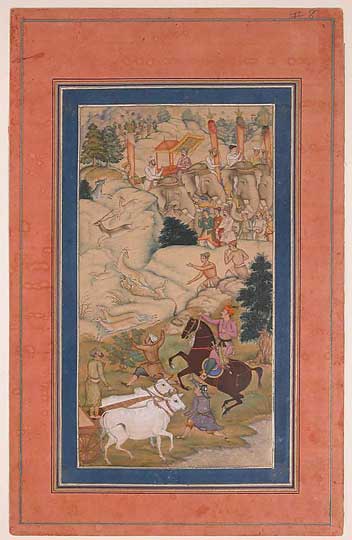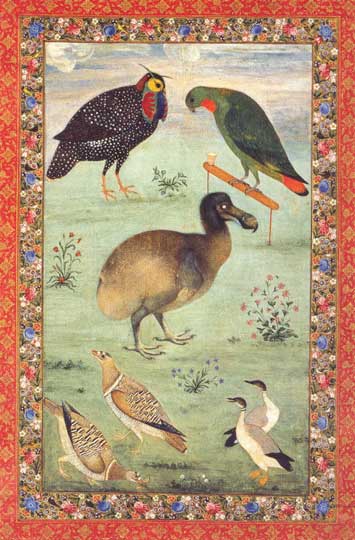The genre of Mughal art is often associated with lavish miniature paintings that depict gruesome, colourful battles and lavish portraits of emperors. However, a plethora of images was dedicated to the flora and fauna of the Mughal Empire and the Indian Subcontinent. These works not only demonstrate the great skill of the artists who rendered them, but also the cultural, religious, literary and scientific interests of the Mughal court.
In the introduction to her book, Birds and Animals in Mughal Miniature Paintings (D.K. Printworld) Zaheda Khanam claims that her work is a ‘humble attempt’ to create the first comprehensive volume on this aspect of Mughal painting. While she acknowledges the work of other scholars in this area, she points out that they only address specific aspects of it. Through 70 colour illustrations and four chapters, Khanam offers a systematic study of birds and animals in Mughal miniatures from the reigns of Akbar (r. 1556–1605) and his son, Jahangir (r. 1605–1627). As an art historian and practicing artist, Khanam discusses these works within both historical and aesthetic contexts.

Akbar Hunting with Cheetahs. A folio from the Akbarnama, India, (c. 1604), attributed to Manohar. Metropolitan Museum of Art, New York
Her first chapter, ‘Fauna in Mughal Paintings’ notes that the Mughal’s interest in animals coincided with the very foundation of the Empire. The first emperor, Babur (r. 1526–1530), created a remarkable diary, Waqat-i Baburi, that refers to a number of creatures he studied on hunting expeditions. His successor Humayun (r. 1530–1540, 1555–1556) commissioned paintings of particular birds which he believed were good omens.
The second chapter, ‘Birds and Animals in Akbari Period’, and the third, ‘Birds and Animals in the Jahangiri Period’, are dedicated to the two emperors under which flora and fauna painting truly flourished. Under Akbar, birds and animals were rendered with great attention to detail but as part of larger narratives. However, under Jahangir, they appeared in individual portraits. These paintings were the result of the emperor’s fascination with natural history. As Khanam demonstrates in chapter four, ‘Aesthetic Analysis’, the way Akbar and Jahangir approached the subject of animals and the works they commissioned had a direct effect on how they were aesthetically represented. Khanam meticulously compares animal imagery under these emperors with the same great attention that the artists paid to create these stunning works.
In Khanam’s introduction, she mentions the profound scholarly contribution of Asok Kumar Das, who has written the second, aforementioned book. Wonders of Nature: Ustad Mansur at the Mughal Court (Marg Publications) is both a beautifully published volume and the first to be dedicated to the artist Ustad Mansur (active 1590–1624). Mansur is known for his magnificent paintings of both Indian flora and fauna. While he served under Akbar, he flourished under Jahangir, who bestowed upon him the honorific title, Nadir al-Asr, or ‘Wonder of the Age’. Das’s work is a culmination of nearly 50 years of research. It is not a catalogue raisonné, but instead paints the illustrious history of Mansur as an artist of the Mughal court.
Das begins by discussing the historical and cultural context of the Mughal court. The next five chapters chronologically explore the artist’s paintings. Two deserve particular mention: chapter four, ‘The Illumination Work of Mansur Naqqash’ delivers a much-needed account of Mansur’s work as a skilled illuminator, with examples of his geometric patterns and border designs. This aspect of the artist’s legacy is often overshadowed, and although it is a break from the book’s overall theme, it is useful to understand the artist and his meticulous techniques.

Study of a Loriquet, Horned Pheasant, Dodo, Ducks, and Partridges (1625), Ustad Mansur, Institute of Oriental Studies, St. Petersburg
Chapter five, ‘Wonder of the Age: Studies of Animals and Birds’, brings together Mansur’s awe-inspiring, painted menagerie. These works, signed and attributed to the artist, span the first quarter of the 17th century, when he was at the height of his career. Das compares Mansur’s paintings with those of his contemporaries, and discusses historical influences such as the introduction to European natural history studies. A personal favourite is the study of the Mauritius Dodo bird (1627), which is, to this day, the most authentic depiction of the ill-fated bird. The book concludes with a look at Mansur’s legacy, and the artist’s impact on depictions of animals until the end of the Mughal Empire in 1857.
Both publications are refreshing and necessary assessments of the significance of animals in Mughal painting. Although Khanam’s book is a broad survey and Das’s is a concentrated examination, they both provide not only insight into the genre of Mughal fauna painting, but also an understanding of Mughal culture and artistic practice as a whole. While these books are a key resource for any scholar or student of South Asian studies, the approachable scholarship and exquisite images make them a great read for any art enthusiast.















![Masterpiece [Re]discovery 2022. Photo: Ben Fisher Photography, courtesy of Masterpiece London](http://zephr.apollo-magazine.com/wp-content/uploads/2022/07/MPL2022_4263.jpg)
‘Like landscape, his objects seem to breathe’: Gordon Baldwin (1932–2025)